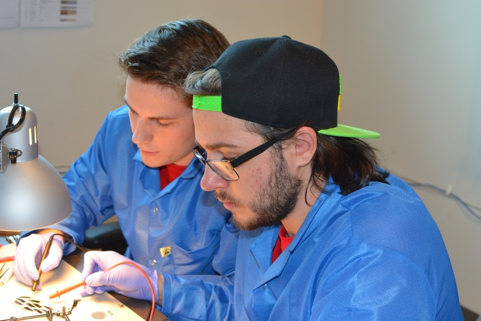Capitol Astronautical Engineering Students Put Finishing Touches on Cactus-1 CubeSat
December 6, 2017It’s the moment every astronautical engineer involved in satellite missions looks forward to: the launch date.
That’s when the weeks of effort – the team meetings and problem-solving sessions, the copious time spent in the lab, the seemingly endless adjustments and rebuilds -- reach their culmination. The planning and preparation transform into measurable results. For the Capitol Technology University astronautical engineering student team involved in the university’s Cactus-1 satellite mission, that moment is fast approaching. NASA is expected to confirm a date for lift-off within the coming months.
“Cactus-1 is launching in the spring or summer of next year and we’re in our final integration steps,” says Dr. Alex “Sandy” Antunes, the astronautical engineering professor who has mentored the student-led project team. “We’re soldering up the flight boards. Instead of green and black practice boards, you’re going to be seeing the white ones that are used for flight. Because they reflect sunlight, they have better thermal properties.”
Although the Cactus-1 payloads – a debris-capturing tool that uses an aerogel substrate, and a communications experiment – have generated the most attention, there are other, less glamorous aspects to the project that require just as much effort, Antunes pointed out.
“There’s also the bus,” he said. “That’s the power and coms and the computer that controls everything and makes it all work. It’s the least sexy and probably most difficult part of the system because if any part of the bus fails, everything dies” Especially since CACTUS-1 involves multiple student teams that depend on each other for overall mission success.
 Lead engineer Pierce Smith, a senior, can be found most afternoons in the clean room of Capitol’s Space Operations Institute (SOI), busily soldering or checking specifications. “We’ve finished most of the design work and have reached the point where we’re saying ‘okay, it’s going to work – we’re ready to build!’"
Lead engineer Pierce Smith, a senior, can be found most afternoons in the clean room of Capitol’s Space Operations Institute (SOI), busily soldering or checking specifications. “We’ve finished most of the design work and have reached the point where we’re saying ‘okay, it’s going to work – we’re ready to build!’"
CACTUS-1 is one of fourteen CubeSats selected for the CubeSat Launch Initiative, representing universities, non-profit organizations, and NASA field centers. Other schools chosen for CSLI include Arizona State, Cornell, Colorado State, Michigan State and the University of Central Florida.
It brings together two student projects – the TRAPSat debris-capturing experiment and Project Hermes, which is exploring methods of satellite command and control via TCP-IP. The teams have morphed over the years as members graduate and new members join.
With the mission now in its final stretch, Smith says it will be deeply rewarding for students to see their endeavors come to fruition.
"I’ve designed a lot of the boards and the mechanical parts and all of those parts are here now. It’s pretty cool to …see them actually made, to see that they will be flying. I think that’s the coolest thing for me," he said.


